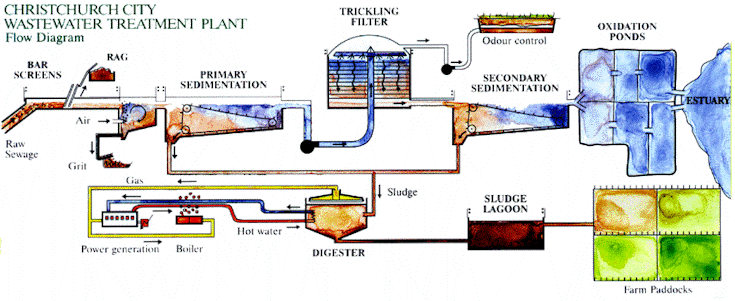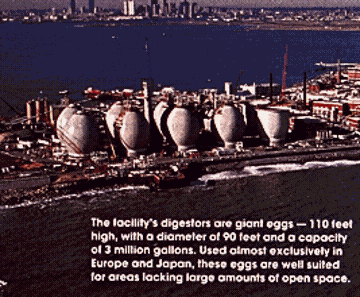Background Information What most plants don't do is utilize the sludge that comes from the bottom of the primary and secondary clarifiers. This sludge is dewatered prior to further processing. At some plants the sludge is trucked off to the landfill in loads of up to 25 tons. At the Christchurch City Treatment Plant some of the sludge is utilized to create methane which is then used to heat the sludge. Here in Daytona the sludge from each treatment plant is piped to a central station and then sold to Enviro Inc. who treats the sludge and sells a portion of it as fertilizer. The rest is then disposed of in the landfill.
If a power plant such as the one in Germany (Institut für Grenzflächen) were combined with a sewage treatment plant then it could easily be utilized to create a biogas. Such a system is in use in a Devon, England sewage plant.
(Boston Harbor) During the 1890’s and 1910’s, Massachusetts’ counties started building sewage treatment plants. During this time period Boston moved from a unsophisticated drainage system to a expansive waste disposal system that dumped raw or partially treated sewage into the Boston Harbor. As a result of the effects of the tides wastewater washed up on the shores of Boston Harbor, creating a cesspool. Due to the wastewater wash-up Boston suffered from an epidemic of diseases, such as cholera and typhoid. For this reason the government started to change the management of the sewage treatment plant. They instituted filtration systems, chemical treatment, tunnels, interceptors, and pumping systems. However, wastewater was still discharged in Boston Harbor. As Boston grew the government created two new sewage treatment plants called Deer Island and Nut Island. One of these new plants, the Deer Island Plant treated 350 million gallons wastewater of per day through the process of digestion. The remaining sludge, approximately 50 dry tons, was released into harbor, following the prevailing theory that the tides would carry it out to sea. In addition to the deliberately dumped sludge, wet weather precipitated the overflow of raw sewage into the harbor, occurring up to 60 times annually and resulting in nearly ten billions of gallons of raw sewage overflow. In response to these conditions, the state legislation, in 1972 ratified the "Clear Water Act" (CWA), which required that the concentration of suspended solids as well as biochemical oxygen in the released water be reduced. Despite the ratification of the CWA Boston tried many methods of circumventing its provisions and by the 1980’s, after years of mismanagement, Boston harbor and its beaches were closed and fishing was prohibited. As a result the Massachusetts legislature sued the Deer Island plant for not enforcing the CWA. After researching documentation revealing the continuous management of the Deer Island sewage treatment plant; the courts forced the MDC (Metropolitan District Commission) to cease releasing wastewater into the harbor as well as to begin enforcing the CWA. The court decided that the MDC would start an 11-year project to rebuild the treatment plant, which would be divided into a primary and secondary sewage treatment system. Two different groups started to fight against/ for the clean up project: the Massachusetts economists and the residents. The residents of the area did not agree on paying the annually required sewage and water rates: in 1985 they amounted to $140; by the 1998 the price was $ 855. The winners were the economists, who defended the idea that the new sewage treatment plant would have significant changes on the local economy. The final argument for their victory was the environmental effect of having clean water in the harbor and sea again after 200 years of having filthy water in the Boston Harbor. The primary treatment has the capacity to treat sewage from 42 communities, which represent 1.3 billion per day. First, the sewage will be pumped through large pipes to the primary clarifiers (the entire facility has 4). Then, the treated sludge is sent to giant digesters (110 feet tall and 90 feet in diameter). 50 tons of sludge per day undergoes this process of digestion. The treated sludge serves as fertilizer to be sold nationwide.
The wastewater remaining from the first treatment plant will be chemically treated. The sludge will go through anaerobic digestion and aeration tanks as well as dechlorination after being clarified and digested a second time. Since the new process has been prepared, the number of closed beaches has been reduced by 50% over the last 4 years. In addition, the new plant will meet the CWA and better safety methods within the facility. |

